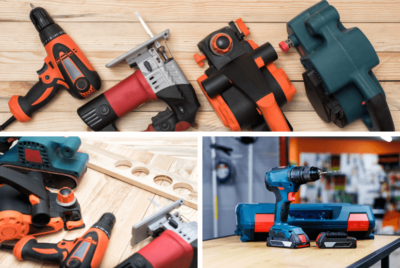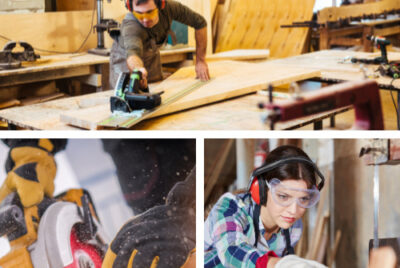27 Types of Clamps and Their Uses
*We may earn a commission for purchases made using our links. Please see our disclosure to learn more.
When we think of clamps, we usually have a specific image in mind. However, clamps come in numerous variations, each with its own advantages and disadvantages. While some are perfect for complex woodworking tasks like panel joinery, others simply serve as an extra pair of hands in the workshop. As DIYers, it’s essential to be familiar with the different types of clamps available. Here, we present 29 types of clamps that every DIYer should know.
Definition of a Clamp:
A clamp is a tool designed to bind, constrict, or press objects or workpieces together.
1.C-Clamp

Best for: General woodworking, automotive repair
Features a C-shaped frame with a fixed jaw and a single-threaded screw for tightening against flat surfaces.
2.Extended Throat C-Clamp

Best for: Woodworking, face gluing boards, automotive
Similar to a C-clamp but with longer jaws, allowing it to apply clamping pressure further toward the center of a workpiece.
3.F-Clamp

Best for: Wood joinery, face gluing boards, holding workpieces
Resembles the letter “F” and utilizes a sliding member along a straight frame, enabling the jaws to hold more material than a C-clamp. Often has large throats for clamping larger materials.
4.Clutch Clamp

Best for: Wood joinery, face gluing boards, holding workpieces
Functions similarly to an F-clamp but employs a clutch to lock the jaws in place. The clutch can be engaged with the thumb to release the jaw’s hold, allowing for one-handed loosening. Precision wood joinery can be compromised due to the potential bowing of the straight bar under pressure.
5.Parallel Clamp

Best for: Wood joinery, panel gluing, large workpieces
Designed to address the bowing issue in F-clamps and clutch clamps. Features a strong bar with two parallel clamping surfaces that maintain contact with the workpiece, aiding in straight glue-ups.
6.Pipe Clamp

Best for: Wood joinery, panel gluing, large workpieces
Consists of two clamp ends mounted on a custom-cut section of galvanized or black steel pipe. One end screws onto the threaded section, while the other slides along the pipe and locks into place. Provides advantages similar to parallel clamps, with the added flexibility of adjusting the clamp length by using a larger pipe section. Budget-friendly option.
7.Trigger Clamp

Best for: Wood joinery, face gluing boards, holding workpieces, one-handed operation
Those clamps resembles an F-clamp but modified for one-handed operation. Features one fixed jaw and one sliding jaw, with a trigger mechanism that applies pressure incrementally by sliding the moving jaw towards the fixed jaw.
8.Spring Hand Clamp

Best for: Holding workpieces and materials
Applies pressure through a spring located at the hinge point, similar to a chip clip. Available in various shapes, sizes, and materials for different applications and strengths.
9.Ratcheting Hand Clamp

Best for: Holding workpieces
Similar to spring hand clamps but uses a ratcheting mechanism instead of a spring to apply pressure incrementally.
10.Bandy Clamps

Best for: Woodworking, gluing edge banding
Spring clamps with a band that spans the two jaws, enabling force to be applied towards the workpiece when positioned on the edge.
11.Gripping Edge Clamp

Best for: Woodworking, gluing edge banding
Features two rubber-coated, spring-loaded cams that lock against a workpiece. A threaded screw with a pivoting head applies pressure against the workpiece’s edge, creating opposite pressures that hold the clamp securely in place.
12.Dual-Spindle Edge Clamps

Best for: Woodworking, gluing edge banding
Specialty clamps used in conjunction with an F-clamp to clamp the edge of a workpiece. Placed between the F-clamp and the workpiece, it utilizes a notch in its frame to apply pressure against the F-clamp’s bar.
13.C-Clamp Edge Clamp

Best for: Woodworking, gluing edge banding
Similar to the dual-spindle edge clamp but doesn’t require an F-clamp. Utilizes the jaws of a C-clamp to hold it to the surface, with a perpendicular screw and pivoting jaw applying pressure towards the workpiece’s edge.
14.Strap Clamps

Best for: Wood joinery, furniture making, irregular workpieces
Utilizes a cloth strap to tighten around irregularly shaped objects. Adjustable plastic pieces can be added to protect the workpiece’s corners.
15.Wooden Hand-Screw Clamps

Best for: Wood joinery, furniture making
Traditional clamps with two wooden jaws connected by opposing threaded screws. The wooden construction helps protect the workpiece’s surface.
16.Locking Plier Clamp

Best for: Holding workpieces
Locking pliers with larger throat and flat clamping surfaces, ideal for quick and temporary holds.
17.Corner Clamp

Best for: Wood joinery, box building, frame building
Those clamps are designed to fit inside a 90-degree joint, applying pressure from the outside using threaded screws with pivoting heads. Ensures precise 90-degree angles for box and frame construction.
18.Self-Squaring Frame Clamp

Best for: Wood joinery, frame construction, box construction
Consists of two V-shaped bars connected by a threaded screw. Sliding 90-degree brackets on each bar hold square workpieces, such as picture frames, while tightening the screw squares the piece and clamps the corners securely.
19.Toggle Clamp

Best for: Holding workpieces to work surfaces
Mounted clamps used to secure materials to work surfaces. Features a jaw that applies pressure from the top, holding the workpiece firmly in place.
20.Fence Clamp

Best for: Holding workpieces to tool fences
Similar to toggle clamps, but specifically designed for securing workpieces to tools with fences, like table saws or miter saws. Often used for positioning stop blocks for repetitive cuts.
21.Drill Press Clamp

Best for: Holding material on a drill press
Clamps or vises designed to hold workpieces steady on a drill press, ensuring precision during drilling operations. Can be easily adjusted for different positions.
22.Spring Miter Clamp

Best for: Holding mitered joints together, frame construction, box construction
Made of spring steel and uses spring tension to hold two workpieces together. Has a minimal footprint and sharp tips that bite into the wood on the outside of a miter joint.
23.Locking Chain Clamp

Best for: Grabbing irregular workpieces, twisting smooth pipes
Resembles locking pliers but with a looped chain instead of jaws. Can tightly lock around irregular-shaped materials or grip smooth pipes securely.
24.Straight-Edge Clamp

Best for: Woodworking, carpentry
A long, straight tool that can be clamped to a workpiece, providing a straight edge for sawing or routing tasks. It effectively transforms a standard circular saw into a track saw.
25.Table Clamp

Best for: Welding, soldering, mounting tools
Small, flat C-clamps used to hold items securely to a table or workstation. They are versatile and can be used for various applications such as holding materials during welding or soldering, or mounting tools onto a surface.
26.Cabinet Face Clamp

Best for: Mounting cabinetry
Specifically designed for mounting cabinets, these clamps feature two perpendicular threaded screws for adjustment. A sliding jaw pulls the cabinets tightly together, while a non-marring head applies pressure to the cabinet faces, ensuring proper alignment. Some cabinet face clamps even have built-in holes for drilling pilot holes through the clamp itself.
27.Flooring Clamp

Best for: Installing flooring
These clamps consist of two independent jaws connected by a strap, and they are used to tightly install tongue-and-groove flooring. One jaw is positioned on a mounted flooring piece, while the other is placed on the piece to be installed. As the strap is tightened, the new piece is securely seated in the fixed piece, freeing the user’s hands for driving fasteners and ensuring a professional flooring installation.
These 27 types of clamps cover a wide range of applications in DIY projects and professional settings. By understanding the strengths and purposes of each clamp, you can select the appropriate one for your specific task, ensuring efficient and precise results.




